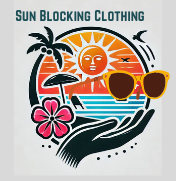If you are aware of What Color Attracts Less Sun, you can make better decisions about sun blocking clothing that may be in your closet already.

What Color Attracts Less Sun? Why does this make a difference?
How does the color of a material affect its temperature?
Can You use some of the clothing you have in your closet to protect yourself from the sun?
Or do you have to buy all UPF rated garments?
Dark-colored surfaces become warmer because they absorb more of the radiation. (energy of the light rays that are absorbed)
So, when the sun shines on your dark sweatshirt, it absorbs the rays and turns them into heat energy.
The more heat (Sunlight) that is absorbed, the warmer your temperature will be when you are wearing your dark-colored sweatshirt.
Light-colored surfaces reflect more of the sun’s radiation. There are fewer heat rays to absorb because more of the energy has been reflected. By absorbing less radiation, there is less warming.
Light-colored clothing reflects more energy or heat. This makes you feel cooler unless the fabric is thin, and the sun rays penetrate the fabric. Then you are not getting any sun blocking protection from the fabric.
You should be cooler wearing lighter colors of clothing.
Thin fabric that is dark will reflect less energy because it has absorbed the heat, but won’t offer you the skin protection you need.
What Color Repels The Sun Best?
Light rays create heat energy. You can feel it on your skin. When searching your existing wardrobe for sun blocking fabrics in regular clothing. White and light colors shirts, sunglasses, and sunhats will reflect the sun off your skin.
With black or dark-colored fabrics, the energy given off with the sun’s rays shining down on the color will absorb into your sweatshirt and be warmer.
In this case, your color is right, but the fabric is not thick enough to protect you from the sun. An older white shirt offers little sun protection.
Color and fabric are both important for protecting your skin and keeping you as cool as possible. Or in the winter as warm as possible.
So now you realize that white and lighter colors reflect the most light.
Black and darker colors act like absorbers and absorb the energy from the sun shining on a black shirt.
The energy in those sun rays creates heat. The heat is absorbed, and your black shirt will keep the sun off of you but maybe hot to wear. There is nowhere for the heat to escape if you are not wearing loose-fitting clothing. A close-fitting black shirt will be warmer to wear.
Loose-fitting clothing will allow the heat created from light-absorbing colors and fabrics to dissipate. Getting air around your body will pull the heat and moisture away from your body.
So, Color, fabric, and fit are important.
What Color Does Not Absorb Light?
White fabric reflects all colors.
Black fabric absorbs all colors.
The Black and very dark colors absorb most of the sun’s light hitting it, so the surface heats up quickly. Because these colors do absorb the light, the sun’s rays will make you warmer when you wear these colors.
In the evenings it won’t matter. We are talking about protecting your skin from the sun, and the damage to your skin if you overexpose your skin to the bright sun.
Black or dark-colored materials and objects radiate (give off) and
absorb heat the fastest.
Darker colors absorb more light. Since light is energy, absorption would increase a material’s temperature. This means that, darker colors
become better radiators of heat.
When an object will appear white if it reflects all colors.
This same object will appear black if it absorbs all colors.
There are different degrees of color and therefore degrees of absorption. Understanding the transformation of light to heat will help you
understand why your skin sunburns in some colors and fabrics.
Sunlight just doesn’t disappear when it strikes a black object. It is transformed into heat.
Lighter colors reflect more light. So, while we think of dark colors as absorbers of heat, actually the darker colors are better absorbers of light.
When a color absorbs light, the light is turned into thermal energy (heat).
The more light a color absorbs, the more thermal energy it produces.
Black fabric absorbs all colors of light and is therefore warmer. As the color black absorbs all colors.
The Color Of A Garment Affects It’s Ability To Warm Or Cool The Wearer
Just a quick review:
When a (colored fabric) absorbs light, it turns the light into thermal energy (heat).
The more light a color absorbs, the more thermal energy it produces. Black fabric absorbs all colors of light and is, therefore, warmer than white fabric which reflects all colors.
As you are moving into more ways to protect your skin from damage from the sun, setting you up for skin cancer in the future, consider the absorbing and reflecting actions of colors.
Clothing and hats are among the simplest and most effective ways to guard your skin from the sun’s harmful rays. They provide a physical block between your skin and the sunlight. Unlike sunscreen, you won’t have to worry about reapplying!
In recent years, clothing manufacturers have begun adding chemicals and additives to fabrics during the production process to further boost the sun protective factor.
How does the color of an object affect its temperature? Because of how the color reacts. Does it absorb the sun’s rays? Or does the color reflect the rays?
Even the color of a liquid can affect that liquid’s temperature.
This is because different colors reflect or absorb different parts of the light spectrum. This means there is more heat in red, orange. Even the color yellow, reflects the warmer light and absorbs the part of the light spectrum that is less hot.
UPF Fabrics
Your color choice is important. However, the fabric is equally important. There are so many fabrics that have been enhanced to protect your skin and be comfortable to wear.
This is what has made the SPF fabric so popular. The comfort, well the comfort and the security of knowing you are blocking the sun as much as you can, and enjoy life outdoors in the sun.
Being able to have skin protection that you know is blocking the sun allowed you to avoid skin cancer, as well as enjoy your time outdoors.
You will find it easier to apply and reapply sunscreen when you have your arms and shoulders covered. When you have your sunhat on as well as your sunglasses.
Sunscreen on your hands, lips, and face lasts longer when you have some protection from the sun with sun blocking clothing.
Is it time for you to start investing in a garment or two, then in a few months maybe another one?
If you can’t do that right now, consider using a product like Rite Sun Guard. You can just launder in some sun protection for your skin.
Adding protection is an ongoing effort. Like eating healthy or taking your vitamins. Taking care of your skin is like brushing your teeth. In time you can have good skin protection habits like your other healthy life habits.
Get started, give yourself time and you too can avoid skin cancer.

Sami’s Take On What Color Attracts Less Sun
Learning about the importance of color will help in your skin protection. Having lived during the time we thought a tan was healthy, have you over-exposed your skin to the sun?
The color that attracts less sun will be white. With pale pastels in close behind. So by reflecting more rays, less will get to your body to burn your skin.
This will mean good skin protection with a light color or white if your fabric is tightly woven and allows no sun through.
How do you know if the sun is coming through? Hold the garment up to the sun. Do you see any sun coming through the fabric?
If you do, the sun will get to you in that garment and you may easily sunburn, even if it is white.
If you do not see any sun through the fabric, you can feel safe for a reasonable exposure time.
Use your sunscreen on your hands if they are exposed. As your face will get the reflected sun rays, a generous application to your face is needed and will be needed again throughout the day.
Wearing your sunhat should help, but with reflected rays, sunscreen application is needed.
Remember your sunglasses are important to your overall sun protection and should be worn when you are out in the sun.
Learn about your sunburn risks.
Take breaks in the shade. Give your body time to cool and have a break from protecting itself. Drink lots of water. You will sunburn faster if you are dehydrated.
Stay out of the sun during the peak summertime hours of 10 AM until 4 PM and keeping your skin free of skin cancer will be a whole lot easier. Taking care of yourself is important.
How will you start protecting your skin?
